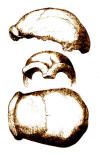All About Neanderthal
Discovery
The official discovery of the Neanderthal species was made in a limestone quarry of the Neander Valley (near Düsseldorf) in August, 1856, three years before Charles Darwin's On the Origin of Species was published.
The type specimen, dubbed
Neanderthal 1, consisted of a skull cap (pictured at right), two femora, three bones from the right arm, two from
the left arm, part of the left ilium, fragments of a scapula, and ribs. The
workers who recovered this material originally thought it to be the remains
of a bear. They gave the material to amateur naturalist Johann Karl Fuhlrott,
who turned the fossils over to anatomist Hermann Schaafhausen. The discovery
was jointly announced in 1857. The species name of neanderthalensis
comes from William King, who first named the species in 1863 at a meeting of
the British Association, and put it into print in the Quarterly Journal of
Science in 1864.
(pictured at right), two femora, three bones from the right arm, two from
the left arm, part of the left ilium, fragments of a scapula, and ribs. The
workers who recovered this material originally thought it to be the remains
of a bear. They gave the material to amateur naturalist Johann Karl Fuhlrott,
who turned the fossils over to anatomist Hermann Schaafhausen. The discovery
was jointly announced in 1857. The species name of neanderthalensis
comes from William King, who first named the species in 1863 at a meeting of
the British Association, and put it into print in the Quarterly Journal of
Science in 1864.
That discovery is now considered
the beginning of paleoanthropology. The discovery in 1856 was not,
however, the first Neanderthal specimens discovered. Two prior
discoveries, in Engis, Belgium in 1829 and Forbes' Quarry, Gibraltar in
1848, were eventually classified as Neanderthal sometime after the 1856
discovery. These and other discoveries led to the idea that these
remains were from ancient Europeans who had played an important role in
modern human origins. The bones of over 400 Neanderthals have been found
since.
While this find was the beginning of
paleoanthropology, it was also the beginning of a long debate that is just a
vigorous today as it was a hundred years ago. German scientist R. Virchow
claimed that it was the skeleton of a diseased Cossack cavalryman, with
thick browridges developed from constantly furrowing his brow in pain. Even
when the validity of remains attributed to Neanderthal were no longer in
such question, the description of Neanderthals was still full of
controversy. M. Boule and H. Vallois were the most prominent of those who
believed that Neanderthals had no place in modern ancestry. These two
supported the idea that Neanderthals were more apelike than human, were of
simian intelligence, and walked in an apelike gait. These perceptions were
based on both the misinterpretation of the La Chapelle-aux-Saints specimen
as typic of the species (this species was an older individual with chronic
arthritis throughout its body), and on the prejudices of these researchers,
who refused to accept any evidence that related Neanderthals closely to
modern Europeans.
If you are not a Christian, and you have been holding out on making a decision for Christ because the Church always preached a message that was contrary to what you saw in the scientific world, then rest assured that the Bible is the inerrant Word of God, and you can believe in Christ and receive salvation, while still believing in an old earth. Click here for more.
Are you a Christian who believes in young earth creationism? Now that we have shown the many difficulties of the young earth creation science model in this and many other articles, how does this impact your Christian life? If you are a young earth creationism believer, click here.
All About Neanderthal
Discovery
To learn more
about old earth creationism, see
Old Earth Belief,
or check out the article
Can You Be A
Christian and Believe in an Old Earth?
Feel free to check out more of this website. Our goal is to
provide rebuttals to the bad science behind young earth creationism,
and honor God by properly presenting His creation.
